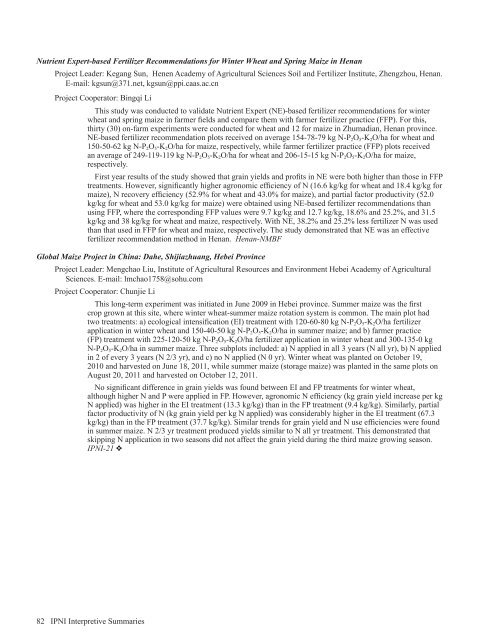Americas and Oceania Group - International Plant Nutrition Institute
Americas and Oceania Group - International Plant Nutrition Institute
Americas and Oceania Group - International Plant Nutrition Institute
You also want an ePaper? Increase the reach of your titles
YUMPU automatically turns print PDFs into web optimized ePapers that Google loves.
Nutrient Expert-based Fertilizer Recommendations for Winter Wheat <strong>and</strong> Spring Maize in Henan<br />
Project Leader: Kegang Sun, Henen Academy of Agricultural Sciences Soil <strong>and</strong> Fertilizer <strong>Institute</strong>, Zhengzhou, Henan.<br />
E-mail: kgsun@371.net, kgsun@ppi.caas.ac.cn<br />
Project Cooperator: Bingqi Li<br />
This study was conducted to validate Nutrient Expert (NE)-based fertilizer recommendations for winter<br />
wheat <strong>and</strong> spring maize in farmer fields <strong>and</strong> compare them with farmer fertilizer practice (FFP). For this,<br />
thirty (30) on-farm experiments were conducted for wheat <strong>and</strong> 12 for maize in Zhumadian, Henan province.<br />
NE-based fertilizer recommendation plots received on average 154-78-79 kg N-P 2 O 5 -K 2 O/ha for wheat <strong>and</strong><br />
150-50-62 kg N-P 2 O 5 -K 2 O/ha for maize, respectively, while farmer fertilizer practice (FFP) plots received<br />
an average of 249-119-119 kg N-P 2 O 5 -K 2 O/ha for wheat <strong>and</strong> 206-15-15 kg N-P 2 O 5 -K 2 O/ha for maize,<br />
respectively.<br />
First year results of the study showed that grain yields <strong>and</strong> profits in NE were both higher than those in FFP<br />
treatments. However, significantly higher agronomic efficiency of N (16.6 kg/kg for wheat <strong>and</strong> 18.4 kg/kg for<br />
maize), N recovery efficiency (52.9% for wheat <strong>and</strong> 43.0% for maize), <strong>and</strong> partial factor productivity (52.0<br />
kg/kg for wheat <strong>and</strong> 53.0 kg/kg for maize) were obtained using NE-based fertilizer recommendations than<br />
using FFP, where the corresponding FFP values were 9.7 kg/kg <strong>and</strong> 12.7 kg/kg, 18.6% <strong>and</strong> 25.2%, <strong>and</strong> 31.5<br />
kg/kg <strong>and</strong> 38 kg/kg for wheat <strong>and</strong> maize, respectively. With NE, 38.2% <strong>and</strong> 25.2% less fertilizer N was used<br />
than that used in FFP for wheat <strong>and</strong> maize, respectively. The study demonstrated that NE was an effective<br />
fertilizer recommendation method in Henan. Henan-NMBF<br />
Global Maize Project in China: Dahe, Shijiazhuang, Hebei Province<br />
Project Leader: Mengchao Liu, <strong>Institute</strong> of Agricultural Resources <strong>and</strong> Environment Hebei Academy of Agricultural<br />
Sciences. E-mail: lmchao1758@sohu.com<br />
Project Cooperator: Chunjie Li<br />
This long-term experiment was initiated in June 2009 in Hebei province. Summer maize was the first<br />
crop grown at this site, where winter wheat-summer maize rotation system is common. The main plot had<br />
two treatments: a) ecological intensification (EI) treatment with 120-60-80 kg N-P 2 O 5 -K 2 O/ha fertilizer<br />
application in winter wheat <strong>and</strong> 150-40-50 kg N-P 2 O 5 -K 2 O/ha in summer maize; <strong>and</strong> b) farmer practice<br />
(FP) treatment with 225-120-50 kg N-P 2 O 5 -K 2 O/ha fertilizer application in winter wheat <strong>and</strong> 300-135-0 kg<br />
N-P 2 O 5 -K 2 O/ha in summer maize. Three subplots included: a) N applied in all 3 years (N all yr), b) N applied<br />
in 2 of every 3 years (N 2/3 yr), <strong>and</strong> c) no N applied (N 0 yr). Winter wheat was planted on October 19,<br />
2010 <strong>and</strong> harvested on June 18, 2011, while summer maize (storage maize) was planted in the same plots on<br />
August 20, 2011 <strong>and</strong> harvested on October 12, 2011.<br />
No significant difference in grain yields was found between EI <strong>and</strong> FP treatments for winter wheat,<br />
although higher N <strong>and</strong> P were applied in FP. However, agronomic N efficiency (kg grain yield increase per kg<br />
N applied) was higher in the EI treatment (13.3 kg/kg) than in the FP treatment (9.4 kg/kg). Similarly, partial<br />
factor productivity of N (kg grain yield per kg N applied) was considerably higher in the EI treatment (67.3<br />
kg/kg) than in the FP treatment (37.7 kg/kg). Similar trends for grain yield <strong>and</strong> N use efficiencies were found<br />
in summer maize. N 2/3 yr treatment produced yields similar to N all yr treatment. This demonstrated that<br />
skipping N application in two seasons did not affect the grain yield during the third maize growing season.<br />
IPNI-21 v<br />
82 IPNI Interpretive Summaries

















